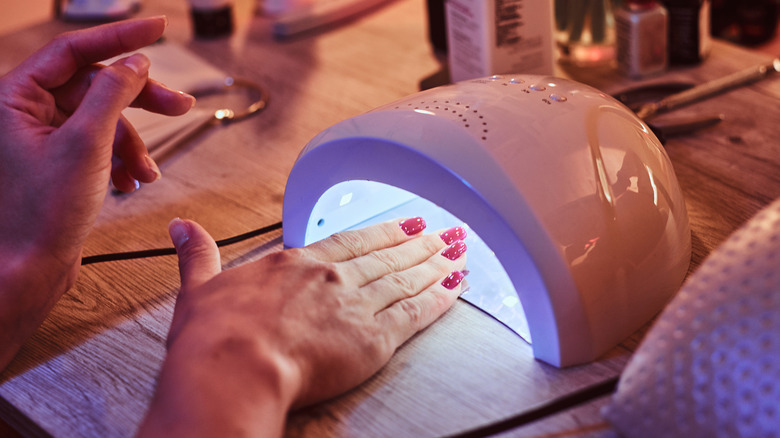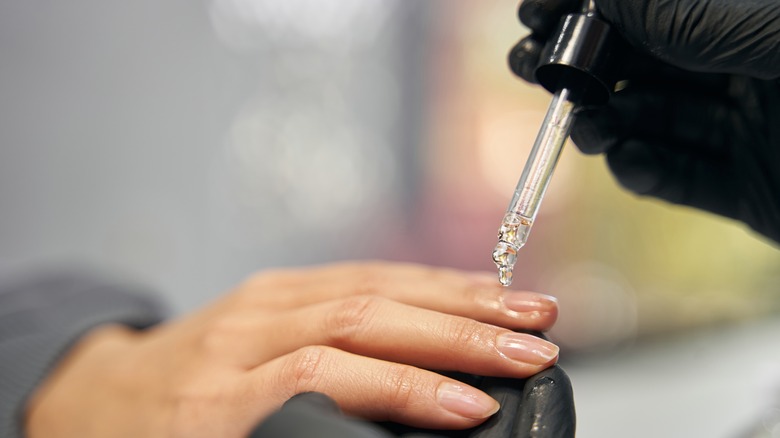Nail Tech Tells Us The Best Alternative To Acrylics For Safer And More Durable Manicures
If you're a regular at the nail salon and love to experiment with the latest acrylic manicure trends, then you likely have some experience in nail maintenance. However, the occasional swipe of cuticle oil doesn't always cut it. Yes, leaving the salon with a fresh set of acrylics makes you feel on top of the world, but acrylics take their toll on your nails and weaken them over time. As fabulous as they are, acrylic nails do cause more yellowing, brittleness, and cracking than other types of nails, such as gel nails. "In my opinion, gel nails, including hard gel and Gel-X nail extensions, are the best alternative to acrylic enhancements," Los Angeles-based nail artist Mycah Dior told Glam during an exclusive talk.
Gel nails consist of ultra-violet (UV) gel that requires an LED lamp for curing, while acrylic is made up of powder that hardens during the process. Acrylic products also increase the risk of developing certain nail conditions, including "worn-down nail syndrome," which results in gradual nail thinning, and onycholysis, a more serious form of nail damage. Therefore, acrylic nails certainly do pose a risk if used frequently or improperly. Thankfully, you have other alternatives to fall back on, which include the many forms of gel nail products.
The safest gel nail alternatives
According to Mycah Dior, "[Gel nails] are much safer due to the flexibility they provide, so you typically wouldn't experience cracking or breaking of your natural nails underneath the enhancement," she explained exclusively to Glam. Soak-off gel nails may still cause peeling and cracking, but they allow more flexibility than acrylic nails, which reduces the likelihood of these issues. "Gel services also might be a bit safer due to the absence of so many harsh chemicals used for the service," Dior added. For instance, there's an increased risk of allergic reactions or contact dermatitis with acrylic nails, which causes redness, irritation, and sometimes pain.
Moreover, there's Gel-X, soft gel overlays, and builder gel overlays, so it's easy to get confused by the different terminology. For the Gel-X method, nail artists use press-on extensions and soft gel polish, which requires an LED lamp for curing and lasts up to three weeks. Soft gel overlays involve applying a gel polish directly on top of your natural nails and last anywhere between two to four weeks. As with Gel-X extensions, you can easily remove soft gel by soaking your nails in acetone. Hard or builder gel overlay, on the other hand, requires an electric file for removal, making it a more risky alternative compared to the former options. If you'd rather skip over all the gel options, consider easy-to-apply press-on nails, dip powders, nail stickers, or a good ol' fashioned regular nail polish.
How to maintain nail health
While gel nails are considered a safer alternative to acrylic nails, gel polish can still lead to brittleness and cracking. "Ultimately, any form of nail enhancement can damage your natural nails if the correct techniques aren't used for application and removal," Mycah Dior shared exclusively with Glam. "So therefore, you should always make sure the nail technician providing the service's number one priority is your natural nails."
In practice, this applies to all nail services, including acrylics. Therefore, the key to rocking acrylics without sacrificing nail health lies with your nail artist. If your nail tech doesn't employ safe techniques for applying and removing acrylics, this increases the risk of nail damage. Similarly, nail DIY-ers should ensure they follow safe steps to remove acrylic nails without causing damage. Whether you opt for acrylic or gel touch-ups, it also helps to implement an at-home nail care routine to support your nails between appointments. This might include cuticle oil to prevent peeling, nail strengthener treatment, and — most importantly — occasional breaks from the nail salon to allow your natural nails to breathe and heal.


